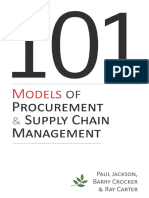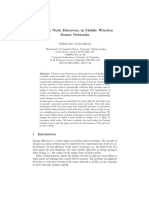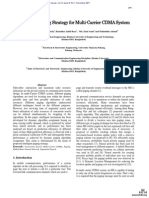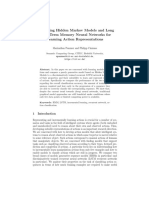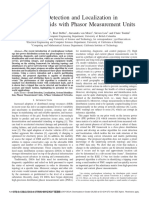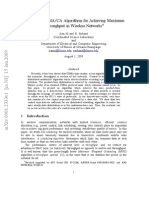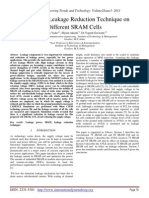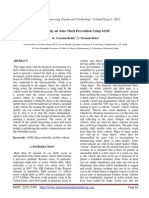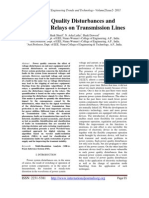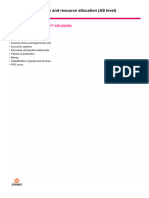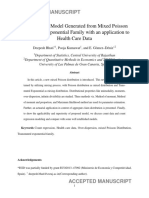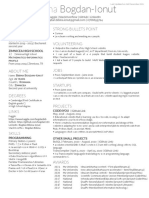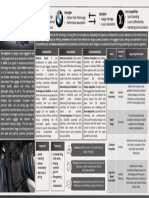Estimation of Blocking Probabilities in A Cellular Network Which Is Prone To Dynamic Losses
Estimation of Blocking Probabilities in A Cellular Network Which Is Prone To Dynamic Losses
Uploaded by
surendiran123Copyright:
Available Formats
Estimation of Blocking Probabilities in A Cellular Network Which Is Prone To Dynamic Losses
Estimation of Blocking Probabilities in A Cellular Network Which Is Prone To Dynamic Losses
Uploaded by
surendiran123Original Title
Copyright
Available Formats
Share this document
Did you find this document useful?
Is this content inappropriate?
Copyright:
Available Formats
Estimation of Blocking Probabilities in A Cellular Network Which Is Prone To Dynamic Losses
Estimation of Blocking Probabilities in A Cellular Network Which Is Prone To Dynamic Losses
Uploaded by
surendiran123Copyright:
Available Formats
International Journal of Computer Trends and Technology- volume3Issue5- 2012
Estimation of Blocking Probabilities In A Cellular Network Which Is Prone To Dynamic Losses
Anuj Kumar, Shilpi Srivastav, Narendra Kumar and Alok Agarwal
Abstract This research paper is intended to evaluate and estimate the blocking probabilities in a typical non-stationary cellular network . Essentially the analysis has been done by addressing the issue of tentative estimation of Modified Offered Load ( MOL ) by using Monte Carlo Simulation , in addition with superlative inspiration from the Importance Sampling ( IS ) Variance Reduction Method .The main objective here is to significantly reduce the number of time points or time intervals for which sampling is required . we essentially use Simulation and subsequently enhance simulation coefficient . Also , in order to reduce repetition of drawing independent samples at every time interval , we will try and construct a ratio approximation method that will facilitate that sample drawn at one point of time may be used at later time intervals . To make the entire assignment robust , we employ Taylor Series Approximation of Variance to check accuracy . As such , this will indicate the direct dependence of the accuracy with respect to the rate by which actual load may change . KeywordsBlocking probability Non-Stationary , Cellular network , mobile network and Simulation. stationary cellular network, the steady state distribution of the system has the well known called object, from which it is easy to obtain analytic expressions for the time dependent blocking probabilities. However, in the non-stationary cellular network the called object does not hold anymore and hence, the time dependent blocking probabilities do not have explicit analytic expressions, either. By using the Modified Offered Load (MOL) approximation, accurate approximations of the blocking probabilities can be obtained. The MOL approximation corresponds to a problem of determining blocking probabilities for a stationary cellular network with an offered load depending on time. We solve a sequence of blocking probabilities for stationary cellular network with different loads, to compute the MOL approximation of blocking probability over
I.
INTRODUCTION
A typical cellular network essentially consist of set of resources to which a cellular call , or more precisely , a call attempt , with an associated holding time and class , arrive at random instances . These holding time & class criteria is governed by BSSAP & MAP Timers , which are set and configured in the HLR , MSC and BSC of the cellular network . Here the situation is being explained only considering a typical 2G Cellular Network . An arriving call or mobile terminating call is either accepted into the system or is blocked , rejected & lost . If the call is admitted into the system to sail through , it remains active in the system for the duration of its holding time , which is governed by the system timers , as explained above or depends upon subscriber behavior . The acceptance of call in the system is decided primarily on the basis of calling class and system resource utilization status. Cellular networks are classical tele-tra c models that have been used to estimate the performance of traditional circuit switched networks which includes the existing fixed telephone networks, as well as cellular networks. Modern broadcast networks have been designed to integrate several services into the same standalone network. The traditional cellular network model uses the theory that the process of arrival of calls into the network can be described by a time homogeneous Poisson process where events occur continuously and independent of one another. But, when the arrival rate of the calls changes considerably over time, this assumption is no more valid . Thus, the cellular network model can be extended so that the calls of a given tra c class are assumed to be generated by a Poisson process with a time varying rate. One of the basic tasks in any cellular network is to evaluate the blocking probability for each tra c class in the system. In the
given time horizon. However, we known that exact evaluation of blocking probabilities for stationary cellular networks representing pragmatic dimension networks is computationally very difficult due to the huge size of the state space. As an alternative, Monte Carlo (MC) simulation can be used to obtain the blocking probabilities which estimates the normalization constant and performance measures. This paper addresses the problem of efficiently estimating the MOL approximation by using MC simulation , with improved ideas from the importance sampling (IS) variance reduction method. The idea is to reduce the number of time points for which sampling is required. The direct method of computing the MOL approximation over a given selected time frame , consists of generating several MC simulation at every time point. With likelihood ratio method, we minimize the number of samples that are generated during the simulation by allowing some controlled reduction of accuracy in the result. Preferably, with likelihood ratio method samples are generated only once and these are used for all time points. To use these samples which generated at some reference time point at other time points requires the samples to be weighted appropriately with the likelihood ratio. This is similar to IS in stationary cellular networks, where it is used to offer better sampling of the most significant parts of the state space. Here, the likelihood ratio is used to scale the result to a different point in time. The method does not obtain extra effort in the simulation and the sample statistics can be used to determine if accuracy is good enough at each time point. When sample statistics imply that at some point of time the variance has become too large, at that time point samples are redrawn. In this paper, we compute approximations to the variance of our estimator to obtain insight into the dependence of the variance on the load. The results are used in different scenario illustrating function of the likelihood ratio method. We consider three application scenarios, where the likelihood ratio method is applied and explain by using arithmetical example. The scenarios correspond to situations, where 1) The likelihood ratio method is used for all time points. 2) The likelihood ratio method is used on-line until it breaks. 3) The on-line method is augmented with a method to estimate a time step into the future up to which the likelihood ratio method can be used.
ISSN: 2231-2803
http://www.internationaljournalssrg.org
Page 733
International Journal of Computer Trends and Technology- volume3Issue5- 2012
II. THE NONSTATIONARY CELLULAR NETWORK
Assume a network having G links, indexed g = 1, . . . , G, with link g having a capacity of Cg resource units. The network supports R classes of calls where r = 1, . . . , R. The call holding time are exponentially distributed with mean 1/r. A class r call, has a bandwidth requirement of bg,r on link g, and bg,r = 0 when class r does not use link g. The vector bg denotes the required bandwidths of all classes on link g. Calls of class r enter according to an inhomogeneous Poisson process with time dependent entrance rate r(t). New calls are always accepted if there is enough capacity and blocked calls are cleared. a product of independent Poisson distributions of the form (1).
IV. FINITE CAPACITY AND THE MOL APPROXIMATION
For the finite capacity system, the set of allowed states, S, consists of those states for which the resulting link occupancies of all the links in the network do not exceed the capacity limit of any link. Formally, S is defined as
S = { x I | g : bg .x Cg } ,
where the scalar product is defined as bg .x = The set of blocking states for a class-r call, Br, consists of those states for which an addition of one more call from class r to a given state results in a link occupancy violating some link capacity constraint,
III. INFINITE CAPACITY
Initially consider a system having infinite link capacities and let X (t) = ( X1(t), X2(t), . . . , XR(t)) represent the state at time t of the infinite capacity system, with Xr (t) recording the number of class r calls in progress at time t. The state space of the process is I = {x | x = ( 1, 2..., R) 0},
Br = { x S | g : bg (x + er) > Cg } ,
where er is a R-element vector with 1 in the r th element and zeros elsewhere. Let X(t) symbolize the state process of the finite capacity system. Alas, contrary to the case in the stationary cellular network, the distribution of X(t) does not anymore have the simple product form of (1). However, as the infinite capacity system still possesses the product form, an appealing approximation (known as the Modified Offered Load Approximation, MOL) for the distribution of X(t) is,
where r N, r = 1, . . . , R , with N denoting the set of natural numbers {0, 1, 2, . . .}. In general Poisson arrival location model in which arrivals move independently through a general state space according to a location stochastic process after arriving according to a non homogeneous Poisson process. It is well known that with inhomogeneous arrivals and the time dependent distribution of the process X(t) that starts empty is a product of independent Poisson distributions, similar to the stationary case
P{ X(t) = x } P{ X (t) = x | X (tS }.(2)
The MOL approximation is recognized to give accurate results when the arrival rate does not vary too quickly compared with the time scale of arrival and departure events i.e. when the load varies slowly and if the blocking probabilities are not too high. This approximation is based on the following
where t > 0 and r(0) = 0 for r = 1, . . . , R . The results in linear stochastic compartmental model i.e open network of infinite server queue also show that the form of the distribution (1) does not depend on the distribution of the call durations. However, for a commonly distributed call duration, Sr, the load r(t) is given by
(i) (ii)
On the relation, in equilibrium, between the system with finite and infinite capacity, where equation (2) is exact. On the explicit equation (1) for the time dependent distribution of the infinite capacity system.
When the initial distribution is Poisson with parameter , distribution (1) can be written as
We also know the analytical expressions and bounds on the error of the MOL approximation for a network with unit size calls and a single link, and for general call sizes and multiple links. We are interested in the prime performance measure which is the instantaneous blocking probability of a class r call at time t, Br(t). It is the probability that an arriving class r call is blocked at time t and is given by
Br(t) = P{ X(t) Br }
where r (0) = r for r = 1, . . . , R. If the initial distribution is a combination of Poisson distribution with the load (l) where l = 1,2..L, the time dependent distribution is the same combination of Poisson distributions, each determined by (1). Further note that (1) is determined by the load only. Routing such as usually happening in wireless network models also leads to an expression for the load and No explicit analytical expressions exist for computing Br(t). In principle, by generating a large number of realizations of the process, one can given enough computer time, to estimate Br(t), at any time point. However, by invoking the MOL approximation, Br(t) can be expressed in the form of a ratio of two state sums
ISSN: 2231-2803
http://www.internationaljournalssrg.org
Page 734
International Journal of Computer Trends and Technology- volume3Issue5- 2012
Br(t)
P { X
(t)
Br
l X
(t)
.(3)
To achieve this, ideas from the importance sampling (IS) variance reduction method are applied. IS is based on the following well known property of choosing the biased distribution which encourages the important regions of the input variable and saves huge run time.Consider a discrete random variable X with distribution p( ),
Computing the MOL approximation at time t consists of computing r(t), r, and then computing the loss probabilities from the time homogeneous cellular network with load r(t).Note that an estimate of r(t), r, as measured from a live network, is su cient , as well. All methods available for stationary cellular networks can be used to evaluate the blocking probabilities for a given fixed time t. Exact computation of these blocking probabilities can be done e ciently only for networks with special topologies and, in practice, approximations are required. Here we investigate the use of simulation method to estimate the blocking probabilities. By using Monte Carlo (MC) methods, one can generate independent samples directly from distribution (1). Here, we study the MC simulation techniques to estimate the MOL approximation of Br(t) for t = [0,T].
and the probability
of a set A, which can be expressed as
The direct MC estimator of
is
Consider another distribution p*( A) , then can be write as
) for X satisfying (p*(
) > 0,
V. THE LIKELIHOOD RATIO METHOD
Here, we suppose that the blocking probability Br(t) is to be estimated for a given traffic class r. Accordingly, the index r is assumed implicit and is omitted, i.e., we denote Br(t) B(t), etc. in addition, note that the simulation requires estimation of two state sums Where Ep* [] denotes expectation with respect to the distribution p*(), and p(X)/ p*(X) is the likelihood ratio. This represent a new estimator of
From these, it is the estimation of (t) that is often inefficient due to the rarity of the blocking states. We assume the probability (t) 1, as it incur much extra computational work as compared with the computational effort of estimating (t) .Thus, in the continuation, we focus on methods for estimating (t). In the straight forward method of computing MOL approximation of (t) for t [0, T ], one basically performs a separate simulation at every time point is used and ( [0, T ]. For each ) is estimated by the standard MC method
Thus, IS allows us to draw the samples from the distribution p*( ), and the bias is corrected with the likelihood ratio. The idea in IS is roughly to choose p*( ) such that it makes the occurrence of the more important samples more probable, thus reducing the number of samples required for estimating . Also, here IS is used to reduce
the number of samples required to estimate ( ). Our idea is to use the likelihood ratio to scale the results across different points in time. Now, assume we have a reference time point and samples ( ) generated from the distribution (x, ) given by (1). At another time point t, the only thing that has changed is the load. Thus, the points generated at time point can be reused at time point t, if the samples are simply weighted with the ratio of the probability of the sample at time t to the probability of the sample
where represents samples drawn from (1) and N is the total number of samples. This assumes that samples are autonomously drawn for each time point. In below mentioned likelihood ratio method, the idea is to minimize the number of samples drawn in the simulations when estimating (t), t [0, T ], by allowing some controlled reduction of accuracy of the estimates at the different time points. Supremely, we want to draw the samples only once, and with those samples estimate ( ) for all .
at time
i.e. the likelihood ratio method, which represent as
Thus, an unbiased estimator for (t) at another time point t is
ISSN: 2231-2803
http://www.internationaljournalssrg.org
Page 735
International Journal of Computer Trends and Technology- volume3Issue5- 2012
expansion of (t) around Where likelihood ratio with the geometric form, is the L(x, . Using the Taylor series expansion of
, t) we can alternatively express (t) as
With the likelihood ratio method the results of all time points can be estimated by scaling the reference time point results with the likelihood ratio. What makes the method applicable is the explicit and simple expression for the likelihood ratio. This may raise the variance beyond an adequate level at some time points. For such points the samples need to be redrawn. Even though the sampling distribution at time t is not asymptotically optimal, assuming that loads do not vary heavily, under-estimation of the variance is not a major problem, since the twisting in the sampling distribution is not that great (it is proportional to the difference in the load at and t). However, if
where at time , and
is short hand for
evaluated
The error term in the Taylor series, Err(x,
,t), equals
the difference in the loads at and t is indeed great, the underestimation problems discussed rigorously. Thus, our method incurs a slight computational increase corresponding to the computation of the statistics of other time points besides the reference time point, but potentially saves a considerable amount of time in that samples do not need to be generated separately for each time point.
.......................(8) for some [ , t]. To gain insight into the error, in observation 1 we relate the expected value of this error to the higher order derivatives of (t). For the variance we need the 2nd moment of ,
VI. ANALYSIS OF THE LIKELIHOOD RATIO METHOD
To know what is the actual computational gain that can be achieved with the likelihood ratio method, we look at how variance of (4) behaves by using following two approaches (1)In first approach, the system is parameterized by time, and we are able to obtain and expression for the variance with respect to time, where the result shows that the expected accuracy depends directly on time. (2)In second approach, the variance is examined with respect to load, and the expected accuracy is characterized by load, which also characterizes the blocking probability. To start with, some simplications in the notation are introduced. Let X* denote the random variable X ( ), and the notation E[] is used to denote expectation with respect to the distribution (1) at the reference time .
Collecting the terms from (7) and (9), we obtain
VII.
VARIANCE WITH RESPECT TO TIME
Thus, we have obtained a characterization of the variance of (4) as a function of terms depending only on random variables at the reference time and the distance at time t from the reference time
In the following we present some analytical results and observations on how the variance of (4) behaves as a function of time relative to our reference time Our idea is to approximate L(x, .
, t) by Taylor series expansion
around .We consider only first two terms of expansion and ignore all the higher terms. First, we note that
. The dependencies are such that the variance depends quadratically in time on the variance of
and where err( ,t) denotes the error terms of the Taylor series
linearly
in
time
on
the
expectation of
. Also, note that (10) is
ISSN: 2231-2803
http://www.internationaljournalssrg.org
Page 736
International Journal of Computer Trends and Technology- volume3Issue5- 2012
simply a 2nd order equation in t. Observation 1: Here we comment on the error of the Taylor series approximation. Initially, it can be observed that the terms in the Taylor series expansions (6) and (7) of (t) satisfy r(t) and the rate of change of the loads, dr(t)/dt, shows that the accuracy is very good for networks with small blocking probabilities, or slowly changing blocking probabilities. This also coincides with the range in which likelihood ratio method is applicable.
VIII.
VARIANCE WITH RESPECT TO LOAD
i.e., the terms of the Taylor series (7) with respect to L(x, , t) coincide term by term with the higher order derivatives of (t) in the Taylor series (6) of . This also follows from the exclusivity of the Taylor series. Thus, the expected value of the error (8) equals
The accuracy of equation (10) has the hitch that it depends explicitly on time, whereas the MOL approximation depends explicitly on the load and implicitly on time, i.e., according to the MOL approximation, the value of B(t) at one time instant t1 relative to its value at another time instant t2 depends only on how much the load has changed from t1 to t2 and not on how far or near t2 and t1 are to each other in time. Therefore, here we capture the effect of the changing load in our approximations
and
for some
,t ]. Further, it can be seen that
. The technique to be used is the same as above, the likelihood ratio is approximated by its Taylor series expansion around the reference load vector.
, r . In conclusion, we note that the error in (t) by using the Taylor series approximation (7) of L(x, , t) is naturally related to the rate of change in (t) which depends on the rate of change of the loads, i.e.,
IX. APPLICATIONS AND ARITHMETICAL EXAMPLES
In this section we introduce three application scenarios where likelihood ratio method is applied and explain them by using numerical examples .The scenario corresponds to the following situations (i) The likelihood ratio method is used to estimate the blocking probability over a given finite time horizon assuming that the load is also known (ii) The likelihood ratio method is used in an on-line algorithm that only utilizes local information of the load and the samples are used until the accuracy criterion fails. (iii) The online version of likelihood ratio method is augmented with a method to estimate a break down point into the future for the accuracy of the method
Observation 2 : Here we bound the true likelihood ratio, i.e., the ratio of the probability of a specified state in the finite nonstationary cellular network at time t to the product form probability of the state in the MOL approximation corresponding to the reference time . To this end, let the real distribution of the finite non-stationary cellular network at time t be denoted here by p(x, t). So, we endeavor to compute
X. MOL APPROXIMATION FOR ALL TIME POINTS
Here we consider the basic problem consider that, for a given r(t), Where L(x, , t) is the likelihood ratio of the two product form probabilities as given by (5), the value of which is explicitly identified. Although the term L*(x, t) can be explicitly characterized, its form is not acquiescent for numerical evaluation. However, L*(x, t) can be bounded in the following manner r, and a predefined set of time points th, with h= 1, . . . , H , how should one compute the MOL approximation of (th), h. This corresponds to computing a discretized approximation to the continuous (t). To apply the likelihood ratio method, we first need to fix an initial reference time or load, let it be * = { 1(t1).. r(t1)}. To make this initial speculation, one should choose a reference load that is similar to most of the different values of loads. According to the likelihood ratio method, samples are generated from the equation (1) with load *, until the relative error is less than 2 1, where 1 is the target relative error to be met by all time points. Choosing 2 < 1,can be used to increase the likelihood that time points having loads that are similar to the reference load will meet the target accuracy 1. The same samples are used in equation (4) to obtain estimates of B r(t), r, and the relative errors of the estimates at all
Note that this bound is increasing in t, which suggests that the accuracy of the MOL approximation decreases with t. The error is clearly determined by the blocking probabilities
ISSN: 2231-2803
http://www.internationaljournalssrg.org
Page 737
International Journal of Computer Trends and Technology- volume3Issue5- 2012
points th, h = 1, . . . , H .During the simulation, estimates of the standard deviations of the estimates are obtained and hence the relative error . Based on these one can observe which time points have not met the relative error 1. For those time points the simulation is performed again and new samples have to be generated from a distribution corresponding to the load at that time. The samples from this new simulation can again be reused for other points in time, where the accuracy criterion failed and that have a load similar to the time point which initially required resampling.
XI. ARITHMETICAL EXAMPLES
We assume a three link star topology network having 3 routes i.e (1,2), (1,3) and (2,3), and two types of calls with bandwidth requirements 1 and 2, respectively. Thus, there are 6 traffic classes all together. The link capacities are C = [70, 70, 70]. Two different load scenarios are considered such that Br(t) 1%, r. In the first scenario, called uniform load, all traffic classes have the same sinusoidal load r(t). In the second scenario, called nonuniform load, the sinusoidal load has a different phase for each traffic class such that 1(t) has phase 0 and the subsequent classes have phases (r 1).
Figure1: Results for the uniform load scenario with standard MC (fig a) and likelihood ratio method (fig b)
for r = 2, . . . , 6. The magnitudes of the loads have been chosen such that blocking probabilities are of the order 1%. Also, in the arithmetical examples we estimate the ratio B(t) = (t)/(t). Thus, the same samples that are used for estimating (t) are used for estimating (t), as well. This results in a ratio estimator, for which the standard deviation can be obtained by using standard methods. All simulations were implemented in Matlab 6.0 and were run under Linux on a 700 MHz Pentium III PC. To compare the performance of the direct MC method and our likelihood ratio method in a fair manner, the sample generation was done in the same way for both the standard MC and the likelihood ratio method. We have used the discretized inverse transformation method, where the necessary Poisson distributions are simply computed into arrays and sample generation corresponds to a table lookup using a linear search. To compute B1(t), the blocking probability of class 1 for 32 evenly spaced time points in the interval [0, 2]. Two accuracy criterions, (1= 0.05, 2= 0.045) and (1= 0.02, 2= 0.018) were used. The results using the likelihood ratio method are compared against results obtained by direct MC simulation, i.e., by performing 32 repeated simulations and at each time point generating samples until an accuracy of 1 is reached.
Figure 1(a) corresponds to the uniform load scenario and shows our estimate of B1(t) and the 95% confidence intervals using the standard MC method with 1= 0.05 accuracy criterion. Figure 1(b) corresponds to the same uniform load scenario and shows the estimate for B1(t) when using the likelihood ratio method for accuracy criterions (1= 0.05, 2= 0.045). The iteration round at which each time point satisfied the target accuracy 1is also shown in the figure via a change of the marker. The 95% confidence intervals are only slightly shorter in magnitude than in the standard MC case.
ISSN: 2231-2803
http://www.internationaljournalssrg.org
Page 738
International Journal of Computer Trends and Technology- volume3Issue5- 2012
Figure 2: Results for the nonuniform load scenario with standard MC (a) and likelihood ratio method (b) Figure2 (a) and (b) show the same results as figure 1(a) and (b), but for the nonuniform load scenario. To account for the above considerations, another variant is introduced of the method in the preceding section. The idea is to use the samples generated at the reference time up to the time when the error limit breaks and then immediately perform resampling. In more detail, at the first time epoch t1, say, samples are again drawn until an accuracy limit 2 is reached. These samples are stored, and at the next time epoch t2 the likelihood ratio method is used to estimate B(t2) and the relative error of the estimate. If the relative error is below the target accuracy 1 the estimate is accepted and the samples are still saved until the next time epoch. If the accuracy criterion fails, new samples are drawn and they are, in turn, saved. The direct MC method is in this case the same as earlier, i.e., samples are redrawn independently at every time epoch. The methods described earlier allow the evaluation of the blocking probabilities at distinct time points, where the distance between time points is assumed to be a constant. But , by doing so one should know that How densely should the discretization points be chosen? For this, we consider an adaptive step size method, where the time interval between successive time points may show a discrepancy. In the on-line setting this means that it is feasible to determine the time into the future upto which the current approximation is good. The Taylor series approximation with respect to time gives us both an approximation for (t) over time relative to a reference time t * and also an estimate for the variance of the equation (4). Thus, the results can be used to characterize the time horizon over which the samples drawn at time t * . As only the constant and the linear terms of the Taylor series approximation of L(x, t* , t ) are considered, the approximation is expected to be accurate only as long as a linear approximation of (t) is applicable. Thus, the used accuracy criterion is also based on the first order characteristics of the simulation, i.e., (t). More specifically, the equation (7) is used during the time where the value of (7) has not changed too much relative to the value of (t * ). Let denote the step size and it is allowed for (t) to change by a factor r = |(t * ) + ) (t * )| / (t * ). Thus, is solved from
XII.
ARITHMETICAL EXAMPLES
We use the same scenarios and the two accuracy criterions (1= 0.05, 2= 0.045) and (1= 0.02, 2= 0.018) as defined previous. In Table 2, the number of samples needed in the simulations and the execution times of the program are shown for each of the cases.
Scenario/Accuracy uniform load /5%
Samples/Running time (LR) 36 000/120 s
As we do not impose restrictions on the second derivatives of (t), in a situation where (t) changes slowly , the above requirement may give a very large step size that may be unjustified due to changes in the load (t), as captured by the error term Err(t *, t). Therefore, we introduce an upper bound, max, on the step size that captures the variability in the load, as mention in observation 1. is finally determined by
uniform load /2% nonuniform load /5% nonuniform load /2%
208 700/690 s
92 400/210 s
..(15) Properly chosen r and max, in equation (15), prevents us from using the Taylor series approximation too far into the volatile future. To obtain from equation (15), one can solve as follows. At time t *= t1, standard MC simulation is performed until the target relative error criterion 1 is reached. During the simulation, =
571 600/1 270 s
As projected, compared with the likelihood ratio method discussed in the previous section, the performance of the on-line variant is almost equal in uniform load Scenario . However, in nonuniform load Scenario the on-line variant outperforms(surpass) the method discussed in the previous section, which is, due to the fact that in nonuniform load Scenario using the samples in all time points wastes computational effort as the samples are only valid for a relatively short period of time. The differences in the execution times are not substantial and can be explained by properties of Matlab. For the online variant samples are stored in a list that is iterated in a for-loop until the accuracy criterion breaks.
and
XIII.
ADAPTIVE STEP SIZE METHOD
need to be estimated. In the interval [t1, t1+ ], (t) is approximated by (7) and an approximate confidence interval can be obtained using (10) for the variance. At time t2= t1+ a new MC simulation is performed and a new is computed . This procedure is continued until T is reached.
ISSN: 2231-2803
http://www.internationaljournalssrg.org
Page 739
International Journal of Computer Trends and Technology- volume3Issue5- 2012
XIV. CONCLUSIONS
Here we discuss the difficulty of efficiently estimating blocking probabilities in a cellular network with time varying arrival rates. By using the MOL approximation the problem can be malformed into one requiring the elucidation of blocking probabilities for a stationary cellular network with a time dependent load. Thus, an ecient simulation method, the likelihood ratio method, has been derived. It utilizes the well known change of probability measure technique of the IS simulation method. Whereas in the IS distribution, the more important events become more frequent. In likelihood ratio method the same idea is used to effectively scale the blocking probabilities of one time point into the blocking probabilities of other time points. In other words, the likelihood ratio method enables us to reuse the samples generated at one time point at other time points, as well, without the need to draw the samples again and again at every considered time point, thus saving potentially a lot of computational effort. To gain insight into what factors affect the performance of the method, the variance of the likelihood ratio estimator has been analyzed by using Taylor series techniques, where it is shown that the variability of the offered load is the key component for prediction of the confidence intervals for the blocking probabilities. Additionally, several variants of the method that can be applied in different practical circumstances have been given. Arithmetical examples comparing the performance of the likelihood ratio method and the standard MC clearly show the efficiency of the likelihood ratio method. The examples clearly demonstrate the efficiency of approach.
XV.
REFERENCES
[1] Multiservice Loss Models for Broadband Telecommunication Networks : K.W. Ross [2] An analysis of the Modified Offered Load approximation for nonstationary Erlang loss model: William .A. Massey, Ward Whitt. [3] Efficient importance sampling for Monte Carlo simulation of loss systems: P. Lassila, J.Virtamo, J.Karvo [4] Fast simulation of blocking probabilities in loss networks: M. Mandjes [5] Networks of infinite server queues with nonstationary Poisson input : William .A. Massey, Ward Whitt [6] Blocking probabilities in mobile communications networks with time varying rates and redialing subscribers: N.Abdalla, R.J. Boucherie, [7] Nearly optimal importance sampling for Monte Carlo simulation of loss systems: P.Lassila, J.Virtamo [8] On the optimality and stability of exponential twisting in Monte Carlo estimation: J.S. Sadowsky [9] Monze-Carlo summation applied to product-form loss networks : K.Ross, J. Wang [10] Monte Carlo Methods and Importance Sampling : Eric C. Anderson
ISSN: 2231-2803
http://www.internationaljournalssrg.org
Page 740
You might also like
- 101 Models of Procurement and Supply Chain Management - Paul Jackson & Barry Crocker & Ray Carter (Jackson, Paul) - 2016 - Cambridge Academic - Anna's ArchiveDocument127 pages101 Models of Procurement and Supply Chain Management - Paul Jackson & Barry Crocker & Ray Carter (Jackson, Paul) - 2016 - Cambridge Academic - Anna's Archivemailrussel.irNo ratings yet
- CPA Self Clicking Strategy For $20 DailyDocument8 pagesCPA Self Clicking Strategy For $20 Dailyfamilybooks1ty100% (1)
- Proposal in Yes-ODocument2 pagesProposal in Yes-OLinrose Go Reyna94% (18)
- Case 2 Marking SchemeDocument22 pagesCase 2 Marking SchemeHello100% (1)
- Whatsapp Chat With Bansaree PatelDocument634 pagesWhatsapp Chat With Bansaree PatelKristie Harris100% (3)
- An Investigative Model For Wimax Networks With Multiple Traffic SummaryDocument14 pagesAn Investigative Model For Wimax Networks With Multiple Traffic SummarySalman ZahidNo ratings yet
- DL Capacity Mgmt-WCDMADocument5 pagesDL Capacity Mgmt-WCDMAMehmet CetinNo ratings yet
- Modeling Congested Internet Connections: Fer.) We Also Assume That The Path Is Fixed, The Transfer IsDocument6 pagesModeling Congested Internet Connections: Fer.) We Also Assume That The Path Is Fixed, The Transfer IsLilika BandeiraNo ratings yet
- Admision ControlDocument34 pagesAdmision Controlmyname06No ratings yet
- Optimal Sequential Paging in Cellular NetworksDocument23 pagesOptimal Sequential Paging in Cellular NetworksVaibhav SharmaNo ratings yet
- Optimal PagingDocument24 pagesOptimal PagingLeur SenacheNo ratings yet
- J Paper Ieee Tap 2013Document13 pagesJ Paper Ieee Tap 2013Ngoc Lan NguyenNo ratings yet
- Modeling and Evaluation of Wireless Sensor Network Protocols by Stochastic Timed AutomataDocument17 pagesModeling and Evaluation of Wireless Sensor Network Protocols by Stochastic Timed AutomataRaka Satria PradanaNo ratings yet
- Distributed Channel Probing For Efficient Transmission Scheduling Over Wireless Fading ChannelsDocument5 pagesDistributed Channel Probing For Efficient Transmission Scheduling Over Wireless Fading ChannelsengineeralshomiNo ratings yet
- An Overview of Cell-Level ATM Network SimulationDocument13 pagesAn Overview of Cell-Level ATM Network SimulationSandeep Singh TomarNo ratings yet
- InglesDocument10 pagesInglesyensiNo ratings yet
- Eective Bandwidth and Fast Simulation of ATM Intree NetworksDocument26 pagesEective Bandwidth and Fast Simulation of ATM Intree NetworksGaurav BanerjeeNo ratings yet
- How User Throughput Depends On The Traffic Demand PDFDocument9 pagesHow User Throughput Depends On The Traffic Demand PDFRedamichael JemberuNo ratings yet
- CDMADocument12 pagesCDMAManoj MoharanaNo ratings yet
- Admission Control in UMTS in The Presence of Shared ChannelsDocument12 pagesAdmission Control in UMTS in The Presence of Shared ChannelsHøuSsi MálejNo ratings yet
- Wlan Probabilistic Model Checking of The (IEEE) 802.11 Wireless Local Area Network Protocol 2002 With Prism Cose in ExamplesDocument19 pagesWlan Probabilistic Model Checking of The (IEEE) 802.11 Wireless Local Area Network Protocol 2002 With Prism Cose in ExamplesHamaad RafiqueNo ratings yet
- On Mobility Load Balancing For LTE SystemsDocument5 pagesOn Mobility Load Balancing For LTE SystemsurfriendlyjoeNo ratings yet
- Thorough Analysis of Downlink Capacity in A WCDMA CellDocument14 pagesThorough Analysis of Downlink Capacity in A WCDMA CellAgus AndriyasNo ratings yet
- Channel Coding Strategies For Cellular RadioDocument15 pagesChannel Coding Strategies For Cellular Radioarjuna1210No ratings yet
- Dcoss08 PDFDocument8 pagesDcoss08 PDFDhruv KhullarNo ratings yet
- Quality of Service in Cognitive Radio Networks With Collaborative SensingDocument5 pagesQuality of Service in Cognitive Radio Networks With Collaborative Sensingsahathermal6633No ratings yet
- Throughput Optimization inDocument14 pagesThroughput Optimization inSHIVANISANDYNo ratings yet
- Transactions Papers: Rickard Stridh, Mats Bengtsson, and BJ Orn OtterstenDocument9 pagesTransactions Papers: Rickard Stridh, Mats Bengtsson, and BJ Orn OtterstenYuvaraj KrishnanNo ratings yet
- Scalable Power Grid Transient Analysis via MOR-Assisted Time-Domain SimulationsDocument5 pagesScalable Power Grid Transient Analysis via MOR-Assisted Time-Domain Simulationsrzyang92No ratings yet
- Intelligent Paging Strategy For Multi-Carrier CDMA System: KeywordsDocument7 pagesIntelligent Paging Strategy For Multi-Carrier CDMA System: KeywordsOpeyemi DadaNo ratings yet
- Adaptive Load Balancing in Mobile Ad Hoc Networks: Shouyi YIN, Xiaokang LINDocument6 pagesAdaptive Load Balancing in Mobile Ad Hoc Networks: Shouyi YIN, Xiaokang LINshrikant.kokateNo ratings yet
- Delay-Bounded Adaptive UFH-based Anti-Jamming Wireless CommunicationDocument9 pagesDelay-Bounded Adaptive UFH-based Anti-Jamming Wireless CommunicationHanif RazvedkaNo ratings yet
- Andrew J. Coyle Boudewijn R. Haverkort William Henderson Charles E. M. Pearce July 29, 1996Document22 pagesAndrew J. Coyle Boudewijn R. Haverkort William Henderson Charles E. M. Pearce July 29, 1996Lily GohNo ratings yet
- HiddenMarkov PredDocument9 pagesHiddenMarkov Predmrcord814800No ratings yet
- Probabilistic Analysis of A Buffer Overflow Duration in Data Transmission in Wireless Sensor NetworksDocument18 pagesProbabilistic Analysis of A Buffer Overflow Duration in Data Transmission in Wireless Sensor Networkschege ng'ang'aNo ratings yet
- AWGN3Document9 pagesAWGN3Mohamed Kadhem KarrayNo ratings yet
- Anomaly Detection and Attribution in Networks With Temporally Correlated TrafficDocument12 pagesAnomaly Detection and Attribution in Networks With Temporally Correlated TrafficVamsi ReddyNo ratings yet
- Circuit Activity Based Logic Synthesis For Low Power Reliable OperationsDocument11 pagesCircuit Activity Based Logic Synthesis For Low Power Reliable OperationsTinyVTNo ratings yet
- CSD 7 BaseDocument13 pagesCSD 7 BaseMani GandanNo ratings yet
- Slotted ALOHA Mobile Packet Communication Systems With Multiuser Detection in A Base StationDocument8 pagesSlotted ALOHA Mobile Packet Communication Systems With Multiuser Detection in A Base StationGopal Jee MishraNo ratings yet
- Protocol Sequences With Carrier Sensing For Wireless Sensor NetworksDocument12 pagesProtocol Sequences With Carrier Sensing For Wireless Sensor Networksdan_intel6735No ratings yet
- Comparing Hidden Markov Models and Long Short Term Memory Neural Networks For Learning Action RepresentationsDocument12 pagesComparing Hidden Markov Models and Long Short Term Memory Neural Networks For Learning Action Representationssun_917443954No ratings yet
- On Opportunistic Power Control For MIMO-OFDM Systems: Norbert Reider G Abor FodorDocument6 pagesOn Opportunistic Power Control For MIMO-OFDM Systems: Norbert Reider G Abor FodorMujeeb AbdullahNo ratings yet
- Censoring Sensors1 PDFDocument4 pagesCensoring Sensors1 PDFRex JimNo ratings yet
- Jecet: Journal of Electronics and Communication Engineering & Technology (JECET)Document6 pagesJecet: Journal of Electronics and Communication Engineering & Technology (JECET)IAEME PublicationNo ratings yet
- Docs 13028992904f8bd9bf648f0Document15 pagesDocs 13028992904f8bd9bf648f0Verruumm AmineNo ratings yet
- International Journal of Computational Engineering Research (IJCER)Document6 pagesInternational Journal of Computational Engineering Research (IJCER)International Journal of computational Engineering research (IJCER)No ratings yet
- Event Detection and Localization in Distribution G 231020 084325Document5 pagesEvent Detection and Localization in Distribution G 231020 084325shiviisc biradarNo ratings yet
- Prediction of Critical Clearing Time Using Artificial Neural NetworkDocument5 pagesPrediction of Critical Clearing Time Using Artificial Neural NetworkSaddam HussainNo ratings yet
- Digital Calculation Protection: of Impedance Transmission LineDocument10 pagesDigital Calculation Protection: of Impedance Transmission Linesirisiri100No ratings yet
- Research Inventy: International Journal of Engineering and ScienceDocument5 pagesResearch Inventy: International Journal of Engineering and ScienceinventyNo ratings yet
- 5 - Lstm-Time-SeriesDocument6 pages5 - Lstm-Time-SerieswilliamNo ratings yet
- 4 PDFDocument25 pages4 PDFĚlîâȟ Gṫȓ GûângûlNo ratings yet
- TSLA: An Energy Efficient Time Synchronization and Localization Algorithm For Underwater Acoustic Sensor NetworksDocument6 pagesTSLA: An Energy Efficient Time Synchronization and Localization Algorithm For Underwater Acoustic Sensor NetworksjazzloveyNo ratings yet
- Traffic SimultaionDocument12 pagesTraffic SimultaionYessyNo ratings yet
- An Optimized K Means Clustering For Improving Accuracy in Traffic ClassificationDocument13 pagesAn Optimized K Means Clustering For Improving Accuracy in Traffic ClassificationCristianNo ratings yet
- Exploiting Directional Antennas To Provide Quality Service and Multipoint Delivery in Mobile Wireless NetworksDocument6 pagesExploiting Directional Antennas To Provide Quality Service and Multipoint Delivery in Mobile Wireless NetworksSatish NaiduNo ratings yet
- Scheduling Algorithms For Multicarrier Wireless Data SystemsDocument9 pagesScheduling Algorithms For Multicarrier Wireless Data SystemsKastuv Mani TuladharNo ratings yet
- Distributed CSMA/CA Algorithms For Achieving Maximum Throughput in Wireless NetworksDocument19 pagesDistributed CSMA/CA Algorithms For Achieving Maximum Throughput in Wireless NetworksMalatesh SudharshanNo ratings yet
- Real-Time Feedback Control of Computer Networks Based On Predicted State EstimationDocument27 pagesReal-Time Feedback Control of Computer Networks Based On Predicted State Estimationbavar88No ratings yet
- Alman Filter Based Ongestion Ontroller: Mehdi MohtashamzadehDocument10 pagesAlman Filter Based Ongestion Ontroller: Mehdi MohtashamzadehijdpsNo ratings yet
- Electrical Power and Energy Systems: SciencedirectDocument9 pagesElectrical Power and Energy Systems: SciencedirectIfedayo OladejiNo ratings yet
- Literature Review 2: Performance Analysis of Wireless NetworksDocument5 pagesLiterature Review 2: Performance Analysis of Wireless NetworksSam NilNo ratings yet
- Spline and Spline Wavelet Methods with Applications to Signal and Image Processing: Volume III: Selected TopicsFrom EverandSpline and Spline Wavelet Methods with Applications to Signal and Image Processing: Volume III: Selected TopicsNo ratings yet
- Attractor Networks: Fundamentals and Applications in Computational NeuroscienceFrom EverandAttractor Networks: Fundamentals and Applications in Computational NeuroscienceNo ratings yet
- Ijett V3i2p204Document3 pagesIjett V3i2p204surendiran123No ratings yet
- Double Encryption Based Secure Biometric Authentication SystemDocument7 pagesDouble Encryption Based Secure Biometric Authentication Systemsurendiran123No ratings yet
- Analysis of Dendrogram Tree For Identifying and Visualizing Trends in Multi-Attribute Transactional DataDocument5 pagesAnalysis of Dendrogram Tree For Identifying and Visualizing Trends in Multi-Attribute Transactional Datasurendiran123No ratings yet
- A Class Based Approach For Medical Classification of Chest PainDocument5 pagesA Class Based Approach For Medical Classification of Chest Painsurendiran123No ratings yet
- PCA Based Image Enhancement in Wavelet DomainDocument5 pagesPCA Based Image Enhancement in Wavelet Domainsurendiran123No ratings yet
- Automated Anomaly and Root Cause Detection in Distributed SystemsDocument6 pagesAutomated Anomaly and Root Cause Detection in Distributed Systemssurendiran123No ratings yet
- Dynamic Modeling and Control of A Wind-Fuel Cell Through Hybrid Energy SystemDocument5 pagesDynamic Modeling and Control of A Wind-Fuel Cell Through Hybrid Energy Systemsurendiran123No ratings yet
- Analysis of Leakage Reduction Technique On Different SRAM CellsDocument6 pagesAnalysis of Leakage Reduction Technique On Different SRAM Cellssurendiran123No ratings yet
- RFID-Based Mobile Robot Positioning - Sensors and TechniquesDocument5 pagesRFID-Based Mobile Robot Positioning - Sensors and Techniquessurendiran123No ratings yet
- Design Architecture For Next Generation Mobile TechnologyDocument6 pagesDesign Architecture For Next Generation Mobile Technologysurendiran123No ratings yet
- Geostatistical Analysis Research: International Journal of Engineering Trends and Technology-Volume2Issue3 - 2011Document8 pagesGeostatistical Analysis Research: International Journal of Engineering Trends and Technology-Volume2Issue3 - 2011surendiran123No ratings yet
- A Study On Auto Theft Prevention Using GSMDocument5 pagesA Study On Auto Theft Prevention Using GSMsurendiran123No ratings yet
- Adaptive Active Constellation Extension Algorithm For Peak-To-Average Ratio Reduction in OfdmDocument11 pagesAdaptive Active Constellation Extension Algorithm For Peak-To-Average Ratio Reduction in Ofdmsurendiran123No ratings yet
- Organizational Practices That Effects Software Quality in Software Engineering ProcessDocument6 pagesOrganizational Practices That Effects Software Quality in Software Engineering Processsurendiran123No ratings yet
- Transformer Less DC - DC Converter With High Step Up Voltage Gain MethodDocument6 pagesTransformer Less DC - DC Converter With High Step Up Voltage Gain Methodsurendiran123No ratings yet
- Dynamic Search Algorithm Used in Unstructured Peer-to-Peer NetworksDocument5 pagesDynamic Search Algorithm Used in Unstructured Peer-to-Peer Networkssurendiran123No ratings yet
- An Efficient Passive Approach For Quality of Service Routing in ManetsDocument6 pagesAn Efficient Passive Approach For Quality of Service Routing in Manetssurendiran123No ratings yet
- Color Feature Extraction of Tomato Leaf DiseasesDocument3 pagesColor Feature Extraction of Tomato Leaf Diseasessurendiran123No ratings yet
- Extended Linearization Technique: GPS User Position UsingDocument4 pagesExtended Linearization Technique: GPS User Position Usingsurendiran123No ratings yet
- Model-Driven Performance For The Pattern and Advancement of Software Exhaustive SystemsDocument6 pagesModel-Driven Performance For The Pattern and Advancement of Software Exhaustive Systemssurendiran123No ratings yet
- VSC Based DSTATCOM & Pulse-Width Modulation For Power Quality ImprovementDocument4 pagesVSC Based DSTATCOM & Pulse-Width Modulation For Power Quality Improvementsurendiran123No ratings yet
- Features Selection and Weight Learning For Punjabi Text SummarizationDocument4 pagesFeatures Selection and Weight Learning For Punjabi Text Summarizationsurendiran123No ratings yet
- Power Quality Disturbances and Protective Relays On Transmission LinesDocument6 pagesPower Quality Disturbances and Protective Relays On Transmission Linessurendiran123No ratings yet
- Experimental Investigation For Welding Aspects of AISI 304 & 316 by Taguchi Technique For The Process of TIG & MIG WeldingDocument6 pagesExperimental Investigation For Welding Aspects of AISI 304 & 316 by Taguchi Technique For The Process of TIG & MIG Weldingsurendiran123No ratings yet
- Model-Based Programming of Intelligent Embedded Systems Through Offline CompilationDocument4 pagesModel-Based Programming of Intelligent Embedded Systems Through Offline Compilationsurendiran123No ratings yet
- Conso CDPDocument153 pagesConso CDPPopoy CanlapanNo ratings yet
- Problem Set 3ADocument3 pagesProblem Set 3AROSEMAY FRANCISCONo ratings yet
- PM800 User GuideDocument122 pagesPM800 User Guidebobi156No ratings yet
- As Level Economics MCQDocument68 pagesAs Level Economics MCQnus jahanNo ratings yet
- Bhati 2016Document32 pagesBhati 2016Mahdi KarimiNo ratings yet
- Disallowed Costs - Guidance and ConsiderationsDocument4 pagesDisallowed Costs - Guidance and ConsiderationsMoonia SheikhNo ratings yet
- Overloading ConstructorsDocument2 pagesOverloading ConstructorsMarcel ChisNo ratings yet
- Paper 17076Document3 pagesPaper 17076mohamed osamaNo ratings yet
- 135 WPS 86Document1 page135 WPS 86munzur zazaNo ratings yet
- LAMP vs. Secretary of Budget and ManagementDocument4 pagesLAMP vs. Secretary of Budget and ManagementAnthony Rey BayhonNo ratings yet
- CELCSPEDocument19 pagesCELCSPEGuillermo O. BernabeNo ratings yet
- Aras2018 - Multidimensional Comprehensive Corporate Sustainability Performance Evaluation Model - Evidence From An Emerging Market Banking SectorDocument26 pagesAras2018 - Multidimensional Comprehensive Corporate Sustainability Performance Evaluation Model - Evidence From An Emerging Market Banking SectoraditeguhNo ratings yet
- Ju 151121023752 0Document24 pagesJu 151121023752 0sadiqali shaikNo ratings yet
- Executive Postgraduate Diploma in Human Resources ManagementDocument26 pagesExecutive Postgraduate Diploma in Human Resources ManagementtnronyNo ratings yet
- Cybercrime and Cyber Security in ASEANDocument15 pagesCybercrime and Cyber Security in ASEANCalin BugaNo ratings yet
- Bibina Bogdan-Ionut: Education Strong Bullets PointDocument1 pageBibina Bogdan-Ionut: Education Strong Bullets PointBogdan BibinaNo ratings yet
- BMW Louis VuittonDocument1 pageBMW Louis Vuitton5mtmxbfx55No ratings yet
- DSA Sheet by Shradha Didi & Aman Bhaiya - Google DriveDocument2 pagesDSA Sheet by Shradha Didi & Aman Bhaiya - Google DriveAdersh PandeyNo ratings yet
- 7 Zip Command Line ExamplesDocument16 pages7 Zip Command Line ExamplesMushtaque AsgharNo ratings yet
- Usulan Alat Lab HidraulikaDocument4 pagesUsulan Alat Lab Hidraulikarobi arianta sembiringNo ratings yet
- Performance Evaluation Form Automation Guidelines FAQsDocument25 pagesPerformance Evaluation Form Automation Guidelines FAQsNicasio AllonarNo ratings yet
- 5279 - SERBADK - AnnualReport - 2019-12-31 - Annual Report (29 May 2020) - Part 4 - 1438596278Document90 pages5279 - SERBADK - AnnualReport - 2019-12-31 - Annual Report (29 May 2020) - Part 4 - 1438596278Cheah ChenNo ratings yet
- Nina BakeryDocument16 pagesNina BakeryAdrian IanNo ratings yet
- Lean Supply ChainDocument5 pagesLean Supply Chainshishir4ruNo ratings yet
- The Revised CIA Syllabus PDFDocument9 pagesThe Revised CIA Syllabus PDFVMendoza MjNo ratings yet
